
USS Susan B. Anthony (AP-72) was a turbo-electric ocean liner, Santa Clara, of the Grace Steamship Company that was built in 1930. Santa Clara was turned over to the War Shipping Administration (WSA) on 28 February 1942 and operated by Grace Lines as agent for WSA as a troop ship making voyages to the South Pacific. The ship was chartered to the Navy on 7 August 1942 for operation as a United States Navy transport ship. The ship was sunk 7 June 1944 off Normandy by a mine while cruising through a swept channel with all 2,689 people aboard being saved.

SS Borinquen, the Taino language name for Puerto Rico, was a passenger liner launched 24 September 1930 and delivered to the Atlantic, Gulf & West Indies Steamship Lines (AGWI) in 1931 for operation by its subsidiary the New York & Porto Rico Line. The line operated the ship until it was requisitioned by the War Shipping Administration (WSA) the last day of 1941 for service as a troop transport. The line then operated the ship as agent for the WSA until 6 May 1944 when operation was transferred to the United States Army for support of the Normandy landings with the ship arriving off the beaches on 7 June 1944. Borinquen continued service post war until redelivered to the owners 14 June 1946. The ship was sold in 1949 and became the Arosa Star. After further sales and change in the cruise ship regulations the ship was again sold and grounded as La Jenelle on the California coast in 1970.

SS The Emerald was a cruise ship owned by Louis Cruise Lines. She was built in 1958 by the Newport News Shipbuilding and Drydock company in Newport News, Virginia, United States, for the Grace Line, as the ocean liner Santa Rosa. Between 1992 and 1995, she sailed for Regency Cruises as Regent Rainbow and between 1997 and 2008, she sailed for Thomson Cruises as The Emerald. Before retiring in 2009, she was the last passenger ship built at a U.S. shipyard that was still in active service.

USS Wharton (AP-7) was a troop transport in the service of the United States Navy during World War II. The ship was originally an Emergency Fleet Corporation Design 1029 type built for the United States Shipping Board. The ship was laid down as Manmasco but renamed and launched as Sea Girt then completed September 1921 as Southern Cross. The ship was first allocated by the United States Shipping Board to the Munson Steamship Line until purchased by the line in 1925. Munson operated the Southern Cross in the South American trade from 1921 until 1938 when the ship was sold at a Marshall's sale and taken over by the United States Maritime Commission which paid the full mortgage claim.

USS Talamanca (AF-15) was the United Fruit Company cargo and passenger liner Talamanca that served as a United States Navy Mizar-class stores ship in World War II.
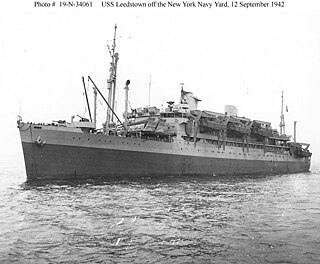
USS Leedstown (AP-73), built as the Grace Line passenger and cargo ocean liner SS Santa Lucia, served as a United States Navy amphibious assault ship in World War II. The ship had first been turned over to the War Shipping Administration (WSA) and operated by Grace Line as the WSA agent from February to August 1942 in the Pacific. In August the ship, at New York, was turned over to the Navy under sub-bareboat charter from WSA. She was sunk 9 November 1942 off the Algerian coast by a German submarine after German bombers caused damage the day before.
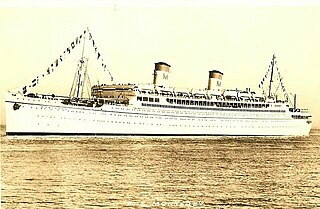
SS Monterey was a luxury ocean liner launched on 10 October 1931. The ship was completed April 1932 and is shown in registers as a 1932 ship. Monterey was the third of the four ships of the Matson Lines "White Fleet", which were designed by William Francis Gibbs and also included SS Malolo, SS Mariposa and SS Lurline. Monterey was identical to Mariposa and very similar to Lurline. During World War II Monterey was used as a troopship operated by Matson as agents of the War Shipping Administration (WSA). Monterey was a large, fast transport capable of sailing independently and was allocated to serving Army troop transport requirements. The ship was involved in an attack on a convoy near Cape Bougaroun.

USS Leonard Wood (APA-12) was built by Bethlehem Shipbuilding Corporation and launched 17 September 1921 at Sparrows Point, Maryland as Nutmeg State, an Emergency Fleet Corporation Design 1029 ship intended as a World War I troop transport, but redesigned upon the armistice as a passenger and cargo ship and completed as Western World for delivery to the United States Shipping Board. The ship's acceptance on 5 May 1922 and delivery on 9 May 1922 marked the completion of the wartime shipbuilding program of the Emergency Fleet Corporation and the Shipping Board.
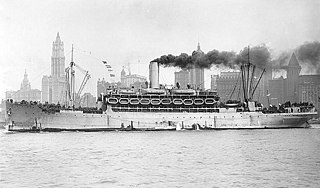
John L. Clem was built as the cargo and passenger liner Santa Ana for W. R. Grace and Company for service in Grace Line's South American service but was requisitioned before completion by the United States Shipping Board (USSB) in 1918 due to World War I. The ship was chartered back to Grace after completion until turned over to the United States Navy to be briefly commissioned as the troop transport USS Santa Ana (ID-2869) from 11 February 1919 to 21 July 1919.
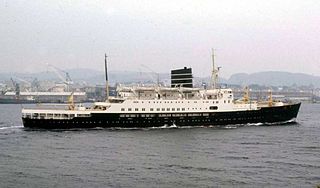
The Bergen Steamship Company (BDS), was founded in 1851 by Michael Krohn to operate a shipping service between the Norwegian ports of Bergen, Stavanger, and Kristiansand and the German port of Hamburg with the paddle steamer Bergen. The company funnel was black with three widely spaced narrow white bands.
For other ships with the same name, see SS Santa Paula.

SS Santa Rosa was a passenger and cargo ocean liner built for the Grace Line for operation by its subsidiary Panama Mail Steamship Company of San Francisco. She was the first to be launched and operating of four sister ships, the others in order of launch being Santa Paula, Santa Lucia and Santa Elena. All four ships, dubbed "The Four Sisters" and "The Big Four" were noted as the finest serving the West Coast and were of advanced technology. All served in World War II as War Shipping Administration (WSA) troop ships. Both Santa Lucia and Santa Elena were lost in air and torpedo attacks off North Africa.

SS Santa Rosa was a passenger/cargo ocean liner in service for the Grace Line and later the American-Hawaiian Steamship Company. The vessel also saw military transport service during both World War I and World War II.

USAHS Marigold was a United States Army hospital ship during World War II. The ship was built as Old North State in 1920 for the United States Shipping Board as a civilian passenger/cargo liner. The ship changed ownership and operating companies several times with name changes to President Van Buren and President Fillmore before being acquired for military transport service in 1941. After government acquisition during World War II President Fillmore served as a War Shipping Administration troop transport before conversion to hospital ship service.

USAHS Acadia was the first United States Army Hospital Ship in World War II. Built in 1932 by Newport News Shipbuilding as a civilian passenger/cargo ocean liner for the Eastern Steamship Lines, the ship was in US coastal and Caribbean service prior to its acquisition by the US Maritime Administration in 1941.

Typaldos Lines, formally known as the Aegean Steam Navigation Company, was a privately held Greek shipping company based in the port of Piraeus, Greece. In 1956 the company had registered its headquarters in London, UK. after operating earlier as Typaldos Brothers Steamship Co. Ltd. The company purchased retired ships and refitted the vessels for passenger cruises and ferry services in the Mediterranean and Greek islands. In 1966 the ferry SS Heraklion sank in the Aegean Sea and over 200 passengers and crew members perished. In 1968 the Greek government investigation of the Heraklion incident found the ship's owners guilty of manslaughter, negligence, and document falsification. Furthermore, twelve of the company's fifteen ships had failed inspection. Haralambos Typaldos and Panayiotis Kokkinos were sentenced to jail. The company was dissolved that year when their ships were taken over or sold.
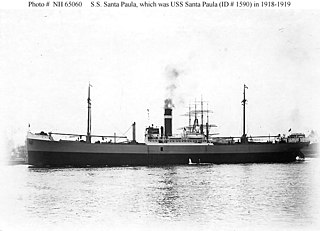
SS Santa Paula was a freighter of the Grace Line and later the American-Hawaiian Steamship Company. The vessel also saw military transport service during both World Wars.

SS Antigua was a United Fruit Company passenger and refrigerated cargo liner completed as one of six nearly identical vessels, three built by Newport News Shipbuilding and three by Bethlehem Shipbuilding Corporation, for operation by the company's subsidiary the United Mail Steamship Company. The ship was the first of the ships built by Bethlehem Shipbuilding Corporation, Quincy, Massachusetts.
SS Haiti was a passenger and freight ship built for the Colombian Mail Steamship Company built at Newport News Shipbuilding, Newport News, Virginia and delivered 15 December 1932. The ship was renamed briefly Puerto Rico in 1938 and Monterey in 1939 to operate for the New York and Cuba Mail Steamship Company until requisitioned with transfer of title to the War Shipping Administration (WSA) on 25 September 1942. The ship was then allocated to the U.S. Army for operation under a bareboat agreement as USAT Monterey. In 1943 the ship was assigned to the command at Trinidad to supply bases in Brazil and Ascension Island. After layup in the reserve fleet the ship was sold to Turkey.
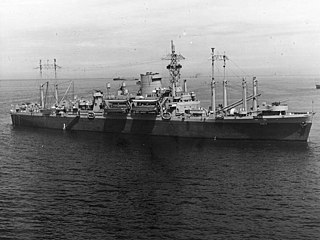
SS Panama was laid down 25 October 1937 as hull number 1467, launched on 24 September 1938 and completed 22 April 1939 at Bethlehem Shipbuilding Corporation in Quincy Massachusetts. The ship was given the official number 238343 and was owned and operated by the Panama Railroad Company. The ship was built for 202 single class passengers with a crew of 124. Panama was sister ship to USS Ancon and SS Cristobal.


















